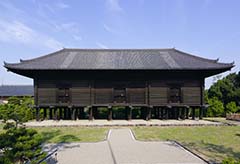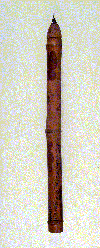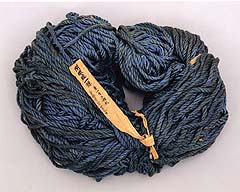The Shosoin Repository
| Photo | Description |
|---|---|
 The Shosoin Repository
(Photo:Imperial Household Agency)  The Brush used for Eye-opening of the newly producted Great Buddha at Todaiji in 752
(Photo:Imperial Household Agency)  The Ink stick used for Eye-opening of the newly producted Great Buddha at Todaiji in 752
(Photo:Imperial Household Agency)  The Blue silk cord used for Eye-opening of the newly producted Great Buddha at Todaiji in 752
(Photo:Imperial Household Agency) |
A “Shoso” meant a large storage of the central or regional government and temples, and the area was called “shosoin”, then it became a proper noun. The Shosoin was formally a repository of the Todaiji temple in Nara, but in 1875 its jurisdiction was transferred to the Ministry of the Interior, and in 1884 to the Imperial Household Ministry. Jurisdiction of the Shosoin now lies with the Imperial Household Agency. The Shosoin, renowned for its azekura style of architecture, in olden times was closed with the seal of the Official of the Minister of Internal Affairs (Responsible for supervising revenue and expenditure as well as keys to storerooms) and in the Kamakura period this position was given to an Imperial envoy, and from the Muromachi period an Imperial seal was used, making the opening and closing of the treasure house an extremely difficult task. It is for this reason that the treasures stocked inside have been able to survive almost in pristine condition to the present day. The old wooden storage which lasted for more than 1200 years since it has been built, was registered as the World Heritage in December 1998 as a part of the Historic Monuments of Ancient Nara. Currently all treasures were transferred from the azekura-style storage and completely housed in two modern storages which were erected in 1953 and 1962. The treasures of the Shosoin come mainly from the Belongings of the Emperor Shomu donated about 1,200 years ago by the Empress(Dowager) Komyo to the Todaiji temple on 21 June 756, the 49 days after the demise of the Emperor Shomu to pray that his soul may rest in peace, and as of 31 March 2010, the catalogued collection held a recorded 8,932 items. Of these treasures, the great majority are those which were used for daily life, such as books, records, calligraphy tools, furniture, musical instruments, amusement gears, costumes, medicines, weaponry, food vessels, Buddhist altar fittings, objects used in annual observances and handicrafts. These treasures are of great artistic and scholarly value and represent the most precious national repository of ancient cultural treasures. They have also been called world treasures. Their characteristics are listed below:
A number of these treasures are displayed every autumn at the Nara National Museum. In addition, reproductions of the treasures are also lent for display purposes. Shosoin website(Opens in a new window) |